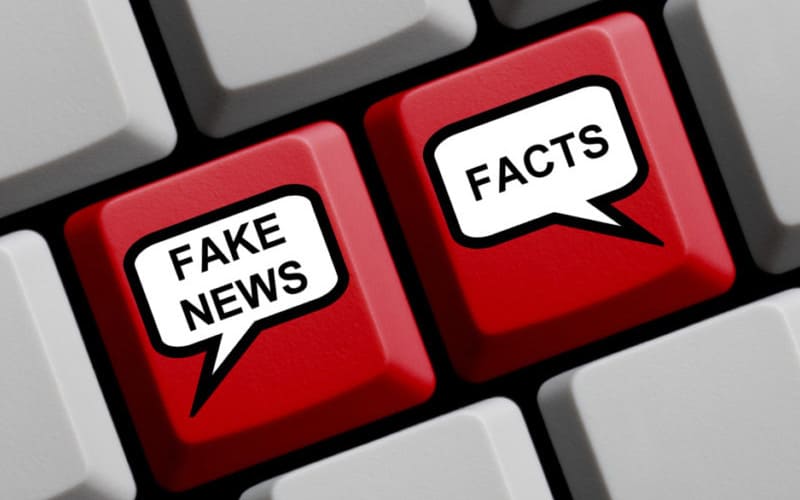How to spot Fake News
Do your best to stop the spread of misinformation
- Last Updated Sep 30, 2020

Fake news is everywhere. Honestly, it’s scary. Especially this year, the spread of misinformation has been almost uncontrollable. Conspiracy theories are spreading like wildfire and there have been countless facts and figures – either used out of context or completely made up – floating around the web regarding the coronavirus pandemic since March. Even before the pandemic, fake news has been integrated in our daily lives since forever, but especially since the rapid rise of social media.
Politicians spread fake news, tabloids spread fake news, even reputable newspapers can fall susceptible to misinformation if one person just happens to misstate the facts. It’s a deep-rooted issue that has the potential to impact society in a big way: from election results to protests about ending 5G.
These days fake news can be so hard to spot, partly because of how fast it spreads (it doesn’t take long these days for fiction to become fact), partly because of how sophisticated it has become. It’s hard to understand where fake news comes from – do the people spreading it have an agenda or do they really believe what they’re saying? It’s made it so even credible sources telling the truth aren’t believed by the masses. The world is losing trust in the press and the media. It’s understandable.
At this point I’m at my wit’s end with it, so I tracked down two media experts to find out how to spot fake news.
Look beyond the headline
Sid Fairbank has researched the problem of fake news extensively and still works in the media for marketing agency, VerriBerri. His first tip might seem obvious, and it is, but you’d be surprised at how many people this one applies to.
According to SEO agency, Moz, 80% of people don’t make it past the headline. That means only two in 10 people will ever get the full story, while the other eight are likely to take the headline at face value. But there’s one thing you need to know about the increasingly online media industry: clicks equal traffic and traffic equals revenue. What gets clicks? A juicy headline.
That’s exactly why it’s called “clickbait”. Sensationalized titles are often somewhat misleading, so it’s important you look beyond the title
“Clickbaity headlines and taglines are great for social media as they get views and shares,” says Sid. “However, make sure you delve deeper into the article as it could just be a misleading headline that isn’t all it seems.”
He goes on to say that context is key: “Without context, you can make any claim seem real,” and gives the example that a headline like “’Celebrity spotted leaving popular London club with model,’” makes it seem like something shocking has happened, but, when you read the article, “explains the woman is a family friend.”
Do your own fact-checking
Now, it’s all well and good telling you to read beyond the headline. But, when an article sets out to be intentionally misleading (or maybe just has the wrong end of the stick), an article’s content might not be completely accurate. This is annoying, I know, because you’d think that, being the news and all, it would just be true. But these days that’s beyond idealistic, unfortunately. But, there are a few simple ways you can fact check what you’re reading to understand whether what they say is true.
First, Fairbank asks, “have they linked their sources?” With everything being online, publications have no excuse not to hyperlink their facts and stats.
He says: “Another good way to tell whether or not something is fake news is through examining the outbound links to the article.” If their links lead you to an opinion piece, non-peer-reviewed study, or just a generally untrustworthy source, it’s likely that what you’re reading isn’t necessarily true.
“Likewise,” he adds, “it’s a red flag if the piece is sparse on sources.” The same can be said for people sharing information on social media; you should always ask for a source.
Another way you can do your own fact-checking is to cross-reference the same story on different media outlets. If it hasn’t been republished anywhere at all, or if it has only been republished by other dodgy outlets, it’s probably safe to discount it as false. “Has the information been shared by a credible source elsewhere?” asks Fairbank. “If someone has made a claim in an article or mentioned something on social media, check if you can find another credible source who has also shared the news
“The likelihood is that it will have been covered a couple of times and a lot of people will be talking about it.”
Helen Reynolds, a social media expert, offers the same advice. “If no credible news source is also reporting it, it is very likely to be fake news,” she says. “My favourite way to check is to search the keywords that describe the story…in Google and then click ‘News’, and then search it on Twitter, too.”
Reynolds also recommends using an established fact-checking site (she recommends Snopes) to search the facts stated in the article: “that will help you to understand the story behind the stories that sound too good to be true.
Credibility is important
The internet is filled with billions of people using millions of sites for a whole variety of purposes. This includes blogs, retailers, newspapers, magazines, and social networking. Out of these millions of websites, few are actually credible.
“Always, always pay attention to the website that has published the story,” says Reynolds. “[Check if] the website seems like it belongs to a credible news organisation [and], if you’re unsure, if the website appears on Snopes’ list of fake news sources, it should ring alarm bells.”
Fairbank agrees and suggests doubling down to check out who actually wrote the story. “This is the most important thing to look for when you are suspicious that something could be fake,” he tells PC Guide. “Look at whether the site had a legitimate journalist working on the article or whether the piece was published on a site that allows public posting (like Wikipedia).”
And finally, when it comes to credibility, Fairbank believes it’s just as important to check who on your newsfeed shared the information. “On your social media platforms you will likely know most of the people you are following and be able to know if they are the kind of person to have researched or even read what they are sharing.” Beyond your intuition, Fairbank says you can check out their previous shares and older posts to see the type of information they share most often and how accurate it is.
Understand the media
Another thing about the media and the articles we see on a daily basis is that it’s rather convoluted. Not every article is a straight news piece. Some are real-life stories based on anecdotal evidence (though credible reporters are likely to get an expert opinion to back up what they’ve found) and some are pure opinion pieces. Opinion writing is a huge part of the press and most newspapers and online publications have whole sections dedicated to opinion articles. Most of them say so, of course, but it’s easy to miss.
Fairbank says, “If the whole piece is an opinion piece or a bunch of information thrown on to the post, question its reliability.” He also notes that pieces based purely on opinion might be an attempt to spread fake news, but they also might be an attempt at satire, which is another perfectly acceptable style of journalism.
Reynolds suggests thinking about who the story is targeted at, especially if it seems sensationalized. “Think about who the story is supposed to be for. Will this make a certain group of people angry? If the story is sensational and backs up a particular viewpoint, you’ve spotted a story that may potentially be fake news,” she says, referencing the 2019 #pizzagate conspiracy that got way out of hand.
Tabloids, especially, are driven by sensational stories and headlines, often reporting on the most obscure news, from celebrity dating to politicians eating their breakfast funny. Tabloids can be credible in their own right, of course, but when it comes to the facts, it’s best to take their articles with a pinch of salt.
Hopefully, these tips will have you better equipped to tackle the giant web of information circulating the internet every single minute. It can be overwhelming, but it’s important to find sources you can trust (otherwise, you’ll never really know what’s going on), and using these tips is definitely a way to do that. Even if it does involve a lot of trial and error.
